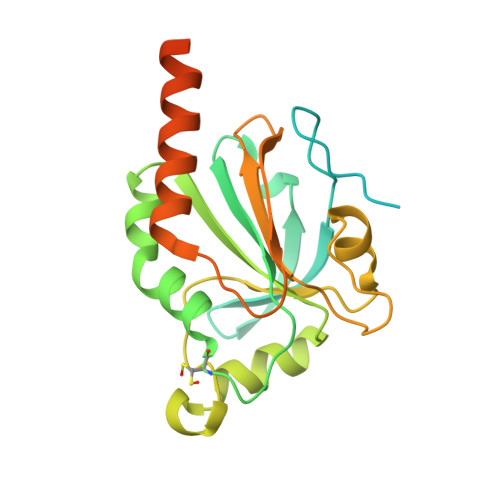Crystal Structure of Reduced and of Oxidized Peroxiredoxin IV Enzyme Reveals a Stable Oxidized Decamer and a Non-disulfide-bonded Intermediate in the Catalytic Cycle.
Cao, Z., Tavender, T.J., Roszak, A.W., Cogdell, R.J., Bulleid, N.J.(2011) J Biol Chem 286: 42257-42266
- PubMed: 21994946
- DOI: https://doi.org/10.1074/jbc.M111.298810
- Primary Citation of Related Structures:
3TJB, 3TJF, 3TJG, 3TJJ, 3TJK - PubMed Abstract:
Peroxiredoxin IV (PrxIV) is an endoplasmic reticulum-localized enzyme that metabolizes the hydrogen peroxide produced by endoplasmic reticulum oxidase 1 (Ero1). It has been shown to play a role in de novo disulfide formation, oxidizing members of the protein disulfide isomerase family of enzymes, and is a member of the typical 2-Cys peroxiredoxin family. We have determined the crystal structure of both reduced and disulfide-bonded, as well as a resolving cysteine mutant of human PrxIV. We show that PrxIV has a similar structure to other typical 2-Cys peroxiredoxins and undergoes a conformational change from a fully folded to a locally unfolded form following the formation of a disulfide between the peroxidatic and resolving cysteine residues. Unlike other mammalian typical 2-Cys peroxiredoxins, we show that human PrxIV forms a stable decameric structure even in its disulfide-bonded state. In addition, the structure of a resolving cysteine mutant reveals an intermediate in the reaction cycle that adopts the locally unfolded conformation. Interestingly the peroxidatic cysteine in the crystal structure is sulfenylated rather than sulfinylated or sulfonylated. In addition, the peroxidatic cysteine in the resolving cysteine mutant is resistant to hyper-oxidation following incubation with high concentrations of hydrogen peroxide. These results highlight some unique properties of PrxIV and suggest that the equilibrium between the fully folded and locally unfolded forms favors the locally unfolded conformation upon sulfenylation of the peroxidatic cysteine residue.
Organizational Affiliation:
Institute of Molecular, Cell and Systems Biology, College of Medical, Veterinary and Life Sciences, University of Glasgow, Glasgow G12 8QQ, Scotland, United Kingdom.















